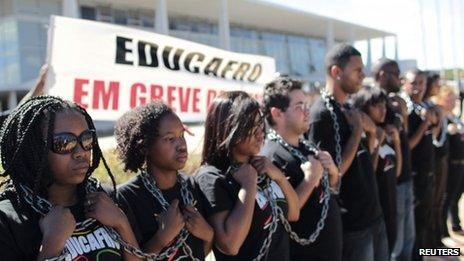Brazil and Colombia have a lot in common and a lot to learn from one another; though they don’t share the same language or colonizers, they do share a similar history and contemporary situation.
Brazil is the largest country in Latin America, with 8,514,877 square kilometers and the largest population in South America, with nearly 199 million people. Colombia is the fourth-largest country in South America, with 1,138,914 square kilometers and nearly 46 million people, the second-largest population in South America. Both countries had large populations of indigenous tribes living there before European colonization, and still have significant communities in rural areas. They also both had large numbers of African slaves who were forced to work the plantations and cash crop farms, some of whom escaped and formed independent communities (palenques in Colombia, quilombos in Brazil). While both countries are ethnically diverse, both have had a difficult time coming to terms with inequality and racism, which is what we’re going to take a look at today.
Both Colombia and Brazil have affirmative action bills in Congress to decide if the government will impose racial quotas. In Colombia’s case, the law would create quotas in universities, government jobs, and the military, with incentives to increase the amount of Afro-Colombians in political parties and corporations. In Brazil, the bill has already been approved by the House of Representatives, and is currently stalled in the Senate. But unlike Colombia’s bill, Brazil’s is much more limited: the law would create racial and socioeconomic quotas in all federal universities (although there are already affirmative action programs at nearly twenty government-run universities). The bill proposes that 50% of all spots at public universities be set aside for students from public high schools; of that 50%, half of the spots would be set aside for blacks and indigenous students, depending on the state’s ethnic make-up, and the other half of the spots would be set aside for low-income students.
But both bills face a great deal of controversy. In the past in both countries, governments have unsuccessfully tried to “whiten” the population, and later created measures to try to prevent racial discrimination. But in both countries, where the myth of racial harmony prevails, there is “structural discrimination” in which blacks make up the poorest and least educated strata of society, more vulnerable to health problems and with higher mortality rates. Though both bills are supported by black civil rights groups, not all blacks support the measure, since some fear would create more racial strife and enforce a separation of ethnic groups.
In addition, both countries have difficulty defining who would be covered by the law, since racial definitions are much vaguer than in countries like the United States. In Colombia’s 2005 census, 10.6% of the population defined itself as black, but experts say that the number is probably around 26%, since some people of mixed race don’t define themselves as black. If this were in fact the case, Colombia would have the largest black population in Latin America after Brazil. According to the Brazilian Institute of Geography and Statistics, 42% of Brazilians consider themselves pardos, or mixed race, and only 7% consider themselves black. Brazil has the largest population of African descendants outside of Africa, but many Brazilians dislike defining themselves based on race.
The other problem with the quotas is that some claim the bills have little to do with discrimination. In Colombia in particular, there are outcries of foreign influence, especially from the United States, since similar affirmative action programs were implemented there, and because the US Black Caucus plays an important role in trade with Colombia. In Brazil, some argue that the problems aren’t related to race, but rather to poverty in general. In both countries, some argue that the law shouldn’t focus on perceived “segregation,” but rather on leveling the playing field with better social and economic policies.
In Colombia, the debate continues as the bill makes its way through Congress, but in Brazil, supporters of affirmative action received an important win last week. The University of Brasilia (UnB) already sets aside 20% of its openings for blacks, and was the first public Brazilian university to do so, in 2004. On July 31st, the head of the Brazilian Supreme Court, Gilmar Mendes, denied an appeal made by the Democratic Party to overturn affirmative action at UnB. The political party argued that the quotas violate the “constitutional right of human dignity” and the universal right to an education. While the judge defended the constitutionality of racial quotas, he emphasized the need to focus more on socioeconomic quotas, rather than racial ones. “In Brazil, it seems there is no distinction between whites and blacks, but rather between the rich and the poor,” he included in his decision.
While both Colombia and Brazil’s legislatures decide the future of affirmative action, they could learn from each other’s experiences and debates. They have a great deal in common and as such, a great deal to offer one another.

Reply